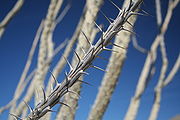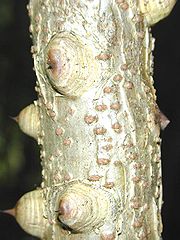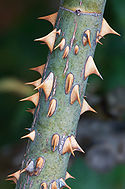
Thorns, spines, and prickles
Encyclopedia




In botanical
Botany
Botany, plant science, or plant biology is a branch of biology that involves the scientific study of plant life. Traditionally, botany also included the study of fungi, algae and viruses...
morphology
Morphology (biology)
In biology, morphology is a branch of bioscience dealing with the study of the form and structure of organisms and their specific structural features....
, thorns, spines, and prickles are hard structures with sharp, or at least pointed, ends. In spite of this common feature, they differ in their growth and development on the plant; they are modified versions of different plant organs, stems, stipules, leaf veins, or hairs. In nontechnical usage, the terms may be synonymous.
- Thorns are modified branches or stemsPlant stemA stem is one of two main structural axes of a vascular plant. The stem is normally divided into nodes and internodes, the nodes hold buds which grow into one or more leaves, inflorescence , conifer cones, roots, other stems etc. The internodes distance one node from another...
. They may be simple or branched.
- Spines are modified leavesLeaves-History:Vocalist Arnar Gudjonsson was formerly the guitarist with Mower, and he was joined by Hallur Hallsson , Arnar Ólafsson , Bjarni Grímsson , and Andri Ásgrímsson . Late in 2001 they played with Emiliana Torrini and drew early praise from the New York Times...
, stipules, or parts of leaves, such as extensions of leaf veins.
- Prickles are comparable to hairs but can be quite coarse (for example Rose prickles), i.e. they are extensions of the cortexCortex (botany)In botany, the cortex is the outer layer of the stem or root of a plant, bounded on the outside by the epidermis and on the inside by the endodermis. It is composed mostly of undifferentiated cells, usually large thin-walled parenchyma cells of the ground tissue system. The outer cortical cells...
and epidermisEpidermis (botany)The epidermis is a single-layered group of cells that covers plants' leaves, flowers, roots and stems. It forms a boundary between the plant and the external environment. The epidermis serves several functions, it protects against water loss, regulates gas exchange, secretes metabolic compounds,...
.
Spinescent is a term used for plants that have sharp structures, but these are not necessarily spines in the technical sense.
Some authors prefer not to distinguish spines from thorns because, like thorns, and unlike prickles, they commonly contain vascular tissue
Vascular tissue
Vascular tissue is a complex conducting tissue, formed of more than one cell type, found in vascular plants. The primary components of vascular tissue are the xylem and phloem. These two tissues transport fluid and nutrients internally. There are also two meristems associated with vascular tissue:...
.
Many plants commonly thought of as having thorns or spines actually have prickles. Rose
Rose
A rose is a woody perennial of the genus Rosa, within the family Rosaceae. There are over 100 species. They form a group of erect shrubs, and climbing or trailing plants, with stems that are often armed with sharp prickles. Flowers are large and showy, in colours ranging from white through yellows...
s, for instance, have prickles.
Evolution
It has been proposed that thorns may first have evolved as a defense mechanism in plants growing in sandy environments which provided inadequate resources for fast regeneration. However, there is no reason to attribute the development of spiny defences to any particular ecological challenge. In some cases, spines have been shown to shade and insulate the plants that grow them (e.g. saguaro cactus spines shade the apical meristem in summer and glochidGlochid
Glochids are hair-like spines or short prickles, generally barbed, found on the areoles of cacti in the sub-family Opuntioideae. Cactus glochids easily detach from the plant and lodge in the skin, causing irritation upon contact...
s insulate the apical meristem in winter).
Morphological variation
Thorns, spines, and prickles occur in a wide variety of ecologies, and their morphology also varies greatly. They occur as sharpened branches (e.g. in CarissaCarissa
Carissa is a genus of about 20-30 species of shrubs or small trees native to tropical and subtropical regions of Africa, Australia and Asia....
, Citrus
Citrus
Citrus is a common term and genus of flowering plants in the rue family, Rutaceae. Citrus is believed to have originated in the part of Southeast Asia bordered by Northeastern India, Myanmar and the Yunnan province of China...
, Crataegus
Crataegus
Crataegus , commonly called hawthorn or thornapple, is a large genus of shrubs and trees in the rose family, Rosaceae, native to temperate regions of the Northern Hemisphere in Europe, Asia and North America. The name hawthorn was originally applied to the species native to northern Europe,...
), spiky inflorescences (e.g. in Tylecodon reticulatus), a tiny point at the tip of the leaf (mucronate leaves) (e.g. in Sansevieria
Sansevieria
Sansevieria is a genus of about 70 species of flowering plants, whose common names include mother-in-law's tongue, devil's tongue, jinn's tongue, bow string hemp, snake plant and snake tongue. It is often included in the genus Dracaena; in the APG III classification system, both genera are placed...
), leaves fully converted to spines (e.g. in Opuntia
Opuntia
Opuntia, also known as nopales or paddle cactus , is a genus in the cactus family, Cactaceae.Currently, only prickly pears are included in this genus of about 200 species distributed throughout most of the Americas. Chollas are now separated into the genus Cylindropuntia, which some still consider...
), stipules converted to spines (e.g. in many Acacia
Acacia
Acacia is a genus of shrubs and trees belonging to the subfamily Mimosoideae of the family Fabaceae, first described in Africa by the Swedish botanist Carl Linnaeus in 1773. Many non-Australian species tend to be thorny, whereas the majority of Australian acacias are not...
), prickles on stems (e.g. of Rosa
Rosa
The name Rosa, Latin and botanic name of the flowering shrub Rose, could refer to:-Places:*223 Rosa, an asteroid*Rosa, Alabama, USA*Rosa, Germany, in Thuringia, Germany*Roşia Nouă village, Petriş Commune, Arad County, Romania-Other uses:...
, Erythrina
Erythrina
Erythrina is a genus of flowering plants in the pea family, Fabaceae. It contains about 130 species, which are distributed in tropical and subtropical regions worldwide. They are trees, growing up to in height...
and Ceiba speciosa), uriticating (i.e. stinging) hairs
Urticating hair
Urticating hairs, i.e. stinging hairs, are one of the primary defense mechanisms used by numerous plants, some New World tarantulas, and various lepidopteran caterpillars. Urtica is Latin for "nettle", and hairs that urticate are characteristic of this type of plant, and many other plants in...
, bristles, and finely barbed spines called glochid
Glochid
Glochids are hair-like spines or short prickles, generally barbed, found on the areoles of cacti in the sub-family Opuntioideae. Cactus glochids easily detach from the plant and lodge in the skin, causing irritation upon contact...
s. Some thorns are hollow and act as myrmecodomatia
Domatia
Domatia are tiny chambers produced by plants that house arthropods.Domatia differ from galls in that they are produced by the plant rather than being induced by their inhabitants...
, others (e.g. in Crataegus monogyna) bear leaves. Thorns of some species are branched (e.g. in Crataegus crus-galli
Crataegus crus-galli
Crataegus crus-galli is a species of hawthorn known by the common names cockspur hawthorn and cockspur thorn. It is native to eastern North America from Ontario to Texas to Florida, and it is widely used in horticulture. This is a small tree growing up to about 10 meters tall and 8 meters wide,...
, Carissa macrocarpa
Carissa macrocarpa
Carissa macrocarpa , is a shrub native to South Africa, where it is commonly called the Large Num-Num. In Zulu, as well as in the Bantu tribes of Uganda, it is called amatungulu. In Afrikaans the fruit is called Noem-Noem.C. macrocarpa deals well with salt-laden winds, making it a good choice for...
).
In human culture
Primitive humans are known to have used thorns as tools. Human history records a variety of cultural references to sharp-pointed plant defensive mechanisms. The Book of Genesis recounts the creation of thorns as one of the punishments for the sin of Adam and Eve, stating "Thorns also and thistles shall [the ground] bring forth to thee; and thou shalt eat the herb of the field." Genesis, 3:18. One of the most enduring cultural images is the Crown of ThornsCrown of Thorns
In Christianity, the Crown of Thorns, one of the instruments of the Passion, was woven of thorn branches and placed on Jesus Christ before his crucifixion...
described in the Bible
Bible
The Bible refers to any one of the collections of the primary religious texts of Judaism and Christianity. There is no common version of the Bible, as the individual books , their contents and their order vary among denominations...
as having been placed on the head of Jesus
Jesus
Jesus of Nazareth , commonly referred to as Jesus Christ or simply as Jesus or Christ, is the central figure of Christianity...
before his crucifixion
Crucifixion of Jesus
The crucifixion of Jesus and his ensuing death is an event that occurred during the 1st century AD. Jesus, who Christians believe is the Son of God as well as the Messiah, was arrested, tried, and sentenced by Pontius Pilate to be scourged, and finally executed on a cross...
. It is mentioned in the Gospel
Gospel
A gospel is an account, often written, that describes the life of Jesus of Nazareth. In a more general sense the term "gospel" may refer to the good news message of the New Testament. It is primarily used in reference to the four canonical gospels of Matthew, Mark, Luke, and John...
s of Matthew
Gospel of Matthew
The Gospel According to Matthew is one of the four canonical gospels, one of the three synoptic gospels, and the first book of the New Testament. It tells of the life, ministry, death, and resurrection of Jesus of Nazareth...
(27:29), Mark
Gospel of Mark
The Gospel According to Mark , commonly shortened to the Gospel of Mark or simply Mark, is the second book of the New Testament. This canonical account of the life of Jesus of Nazareth is one of the three synoptic gospels. It was thought to be an epitome, which accounts for its place as the second...
(15:17), and John
Gospel of John
The Gospel According to John , commonly referred to as the Gospel of John or simply John, and often referred to in New Testament scholarship as the Fourth Gospel, is an account of the public ministry of Jesus...
(19:2, 5) and is often alluded to by the early Christian Fathers, such as Clement of Alexandria
Clement of Alexandria
Titus Flavius Clemens , known as Clement of Alexandria , was a Christian theologian and the head of the noted Catechetical School of Alexandria. Clement is best remembered as the teacher of Origen...
, Origen
Origen
Origen , or Origen Adamantius, 184/5–253/4, was an early Christian Alexandrian scholar and theologian, and one of the most distinguished writers of the early Church. As early as the fourth century, his orthodoxy was suspect, in part because he believed in the pre-existence of souls...
, and others. For example, John the Evangelist
John the Evangelist
Saint John the Evangelist is the conventional name for the author of the Gospel of John...
states that "the soldiers plaited a crown of thorns, and put it on his head". (KJV, ch. 19). The biblical account does not specify what kind of thorns were involved, and leaves no clues from which to determine whether these were biologically classifiable as thorns, spines, or prickles. In modern times, the oxygen
Oxygen
Oxygen is the element with atomic number 8 and represented by the symbol O. Its name derives from the Greek roots ὀξύς and -γενής , because at the time of naming, it was mistakenly thought that all acids required oxygen in their composition...
isotope
Isotope
Isotopes are variants of atoms of a particular chemical element, which have differing numbers of neutrons. Atoms of a particular element by definition must contain the same number of protons but may have a distinct number of neutrons which differs from atom to atom, without changing the designation...
composition of spines from saguaro
Saguaro
The saguaro is a large, tree-sized cactus species in the monotypic genus Carnegiea. It is native to the Sonoran Desert in the U.S. state of Arizona, the Mexican state of Sonora, a small part of Baja California in the San Felipe Desert and an extremely small area of California, U.S...
cactus have been shown to record changes in local rainfall and can be used to reconstruct climate
Climate
Climate encompasses the statistics of temperature, humidity, atmospheric pressure, wind, rainfall, atmospheric particle count and other meteorological elemental measurements in a given region over long periods...
and plant ecophysiology
Ecophysiology
Ecophysiology or environmental physiology is a biological discipline which studies the adaptation of organism's physiology to environmental conditions...
over the plant's lifetime Acanthochronology
Acanthochronology
Acanthochronology is the interdisciplinary study of cactus spines or Euphorbia thorns grown in time ordered sequence . Physical, morphological or chemical characteristics and information about the relative order or absolute age of the spines or thorns is used to study past climate or plant...
.
An early popular myth involving a thorn is that of Androcles, a fugitive slave in ancient Greece who was said to have befriended a lion by pulling a thorn from the lion's paw.
The status of the Scottish Thistle as the national emblem of Scotland is founded on the story (recounted here) that an invading Norse army attempting a night attack was betrayed when they encountered a thistle in the dark.
Plants bearing thorns, spines, or prickles are often used as a defense against burglary
Burglary
Burglary is a crime, the essence of which is illicit entry into a building for the purposes of committing an offense. Usually that offense will be theft, but most jurisdictions specify others which fall within the ambit of burglary...
, being strategically planted below windows or around the entire perimeter of a property.
They also have been used to protect crops and livestock against marauding animals. Examples include hawthorn
Crataegus
Crataegus , commonly called hawthorn or thornapple, is a large genus of shrubs and trees in the rose family, Rosaceae, native to temperate regions of the Northern Hemisphere in Europe, Asia and North America. The name hawthorn was originally applied to the species native to northern Europe,...
hedges in Europe, Agaves
Agave
Agave is a genus of monocots. The plants are perennial, but each rosette flowers once and then dies ; they are commonly known as the century plant....
in the Americas and in other countries where they have been introduced, Osage Orange in the prairie states of the US, and Sansevieria
Sansevieria
Sansevieria is a genus of about 70 species of flowering plants, whose common names include mother-in-law's tongue, devil's tongue, jinn's tongue, bow string hemp, snake plant and snake tongue. It is often included in the genus Dracaena; in the APG III classification system, both genera are placed...
in Africa.

